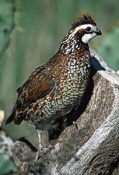|
|

|
|
Bobwhite Quail  The Bobwhite Quail (Colinus virginianus) is a hen-like, ground-dwelling bird, native
to North America. The name derives from their characteristic call (a two-note,
rising "Bob-WHITE"") The Bobwhite Quail (Colinus virginianus) is a hen-like, ground-dwelling bird, native
to North America. The name derives from their characteristic call (a two-note,
rising "Bob-WHITE"")
The Bobwhite Quail is a member of the group of species known as quail. It is a popular game bird, particularly in the Southeast, forming what are known as "coveys," groups of five to thirty birds, during the non-breeding season (roughly October-April). Quail primarily inhabit areas of early successional growth dominated by various species of pine, hardwood, woody, and herbaceous growth. However, quail habitat varies greatly throughout their range which extends north from Mexico east to Florida and north into the Upper Midwest and Northeast. Bobwhites are distinguished by a black cap and black stripe behind the eye along the head. The area in between is white on males and yellow-brown on females. The body is brown, speckled in places with black or white on both sexes, and average weight is five to six ounces (145-200 grams). During the breeding season, typically beginning in mid-April, bobwhite coveys dissolve. Social pairs are typically formed between individuals of unknown relationship. These social pairings potentially result in the formation of a mate bond and subsequent female fertilization and egg formation. Eggs are laid at a rate of approximately one per day, and they hatch after 23 days. Both males and females can incubate nests, with most nests predominately incubated by females. If the first clutch of eggs is unsuccesful, a breeding pair (which may be the same pair, or a different pair as that which led to the previous nesting attempt) will attempt to lay, incubate, and hatch additional clutches. If the clutch is successful, chicks are precocial (meaning, relatively active and nearly self-sufficient) and will leave the nest approximately 24 hours following hatching. The breeding season continues until mid-October, and succesful nesters (females) can potentially lay, incubate, and hatch up to three clutches in a season. A careful, and lucky person walking in the field or woods may come across a sleeping covey of quail and see something remarkable: they will often form a perfect circle on the ground, tail-in, to enjoy the warmth of their fellow birds, and to benefit from having eyes and ears covering every approach. A keen-eyed veteran of the uplands will even been able to spot the matted cover and feathers where a sleeping covey had been the night before. Certainly, your dog will find it! Bobwhites were previously classed with the Old World quails in the pheasant family Phasianidae, but are not particularly closely related and are now given their own family, Odontophoridae. No matter how you classify them, you'll probably enjoy eating them. Game bird gourmands have developed many fine recipes that show off the quail's small, but meaty attributes. Browse The EU Here: A-C | D-F | G-I | J-L | M-O | P-R | S-V | W-Z |
|
^Top | Home | About UplandLife.com | Contact Us | Advertising/Listings | Privacy / Policies | Site Map Entire contents copyright © 2024 UplandLife.com, All Rights Reserved. Content Technology From NorseCode. |